10 Best Manometers Reviews & Ratings
Manometers are for gauging pressure in a fluid or gas column and is used by technicians and professionals in measuring industries. Typically, the device is u-shaped with two graduated legs and have a liquid that will rise anytime pressure acts upon it. The liquid acts such that when the two legs are exposed to the same pressure, the height of the liquid will be the same in both columns. However, should a liquid be applied in the left column, the liquid level on the left falls while that on the right rises until the fluid and the pressure balance. The difference in height is the pressure of the fluid or gas that was in doubt.
Our Top 3 Picks
[srpshortcode id=”21701″][/srpshortcode][srpshortcode id=”21702″][/srpshortcode][srpshortcode id=”21703″][/srpshortcode]
Nevertheless, picking a manometer is a challenge. Companies are specializing in different types of manometers flooding the market with various designs; some analog while others are digital. Therefore, picking the right gadget will be a device. However, below is a buying guide so you can make an informed decision but you can also check our recommendations for some of the best tools in the market.
10 Best Manometers
1. Fieldpiece Dual-Port Manometer - SDMN5
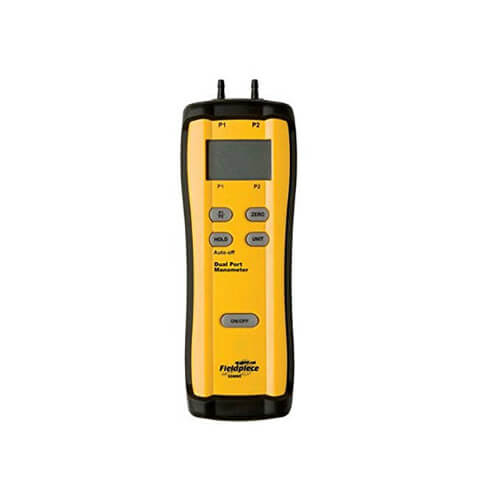
First, it measures both static, gas, and differential pressure. It also includes some fancy features such as the zero-adjust button on the face of the device and a sturdy rubber boot. You will also appreciate that it has an auto on and off that will conserve the battery whenever the unit is not in use. The digital display is also easy to read. As for the readings, the SDMN5 measures pressure from -60inWC to 60inWC or -150.0 to 150.0mBar. Another exciting feature of the unit is that you can use the resolution mode to take the static pressure. However, our top features were the adapter and the magnet at the back.
Magnet - The magnet on the rear helps in hanging the manometer during service. It is a nifty feature especially for HVACR professionals who when measuring pressure between two points.
Adapter – The SDMN5 includes an adapter that measures pressure from 3/16 to 5/16 inches. It is an add-on which adds to the versatility of the gadget.
Included: 1 9V battery
Battery life: 200 hours
Weight: 1.2 pounds
Dual port manometer
Who is it for?
The Field Piece SDMN5 is best for HVACR professionals, and for anyone who wants to measure pressure between two points.
It is accurate
It is easy to use
It is reasonably priced, and you are getting a premium product at an affordable rate
It does not have a backlight which is handy in areas where there is low visibility
2. UEi Test Instruments EM201B
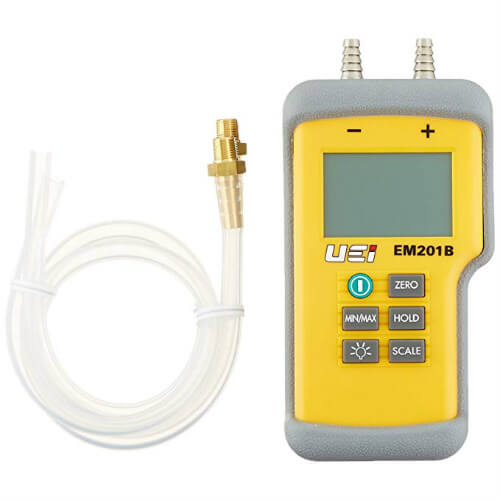
One fascinating feature of the UEI EM201B is that it measures static pressure in inWC, mBar, PSI, or Pa. You can use the inWC when in the USA and the mBar in other nations such as Canada. Also, it has a maximum reading of 60inWc, unlike the Testo which has a max of 50inWC. You will also appreciate that it is easy to use, and quality housing.
Easy to use – First, the EM201B has an integral magnet that allows you to clip on any metal surface for uninterrupted operation. You don’t have to worry about placing it on an even surface and, you don’t have to fumble it in your hands. Also, there is nearly a button for every function. First, it has an on, and off button, a zero adjust button that clears all readings, a scale button allowing you to measure pressure using your preferred scale, and a backlit digital display for low visibility areas. However, our best features were the dynamic min and max capture, and the data hold function.
Housing – The UEI EM201B is rugged, and you can expect it to last. The metal fittings are top quality and has a rubber shell that allows it to withstand bumps and slight abuse.
Has a data hold function and an integral min and max capture.
Backlit display
Measures up to 60inWC
Weight: 0.48 ounces
Who is it for?
The EM201 is a differential pressure and is used to measure static pressure in ducts. HVAC specialists will appreciate the device as will homeowners for measuring gas pressure.
The device has a high resolution, and it is accurate
The magnets are handy to hold the tool on any ferrous surface
The user interface is intuitive, and thus there is no learning curve
It does not work in cold temperatures
The power button also happens to be quite sensitive
3. Extech HD755
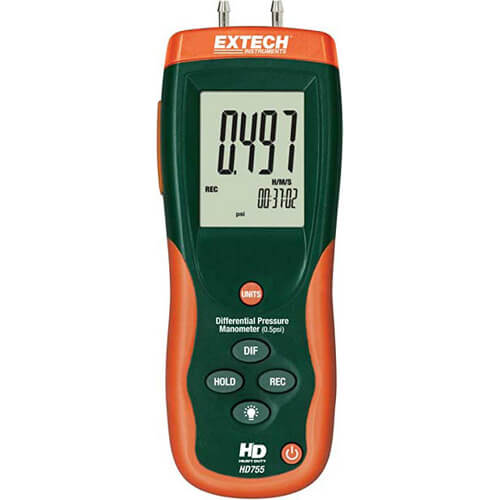
Another fascinating feature of the HD755 is the large LCD. Taking readings will be a breeze especially in low lit areas owing to the backlight. Using the Extech HD755 is simple enough as it includes all the buttons for various functions. The power button for turning the unit on and off, a unit button for selecting the unit of measure, a record button to record min, max, and average, hold and zero button that clears all readings but also holds data, and a dif button to display the differential pressure.
However, our best features were versatility and PC compatibility.
Compatibility – The HD755 is compatible with any windows computer and thus you can transfer all your readings and make comparisons or study trends.
Versatility – First, the LCD can display nine readings at a go. It has a USB data output active reader, a differential pressure mode, data hold, a primary display, record mode, min/max/avg indicators, low battery indicator, elapsed timer, and pressure unit of measure. Moreover, it has an auto-power off feature, and it has 11 units of measure including mBar, PSI, inHg, kPa, etc.
11 units of measure
Large LCD
Includes a 9V battery
Who is it for?
The Extech HD755 is a professional tool, and we recommend it for people repairing burners, HVAC, or any servicing professional.
It is versatile and accommodates people with different needs
They are reliable and remain accurate throughout their life
Includes a magnetic strap allowing you to strap it onto a ferrous metal for uninterrupted operation
It can be pricey, and the 11 units of measure can be a bit confusing
4. Dwyer Series Mark II 25
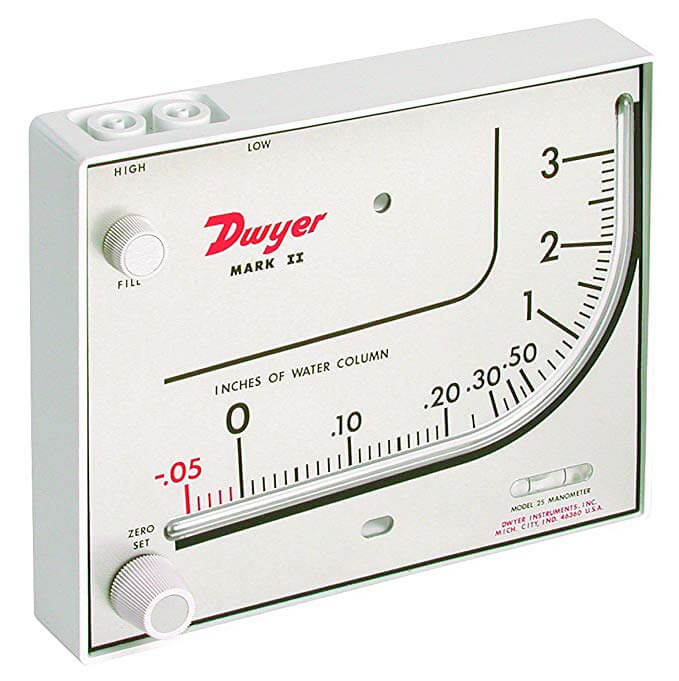
Another remarkable feature of the device is the built-in zero lever that allows linear recalibration. It also happens to be portable thanks to the A-612 stand and tubing that can be slipped over the pressure connections containing the gauge fluid while in transit.
However, what makes it such a hit is the price. The Dwyer Mark II is a low-cost unit at a fraction of the cost of other units. Our best features though were the expanded scale and the build.
Construction – The Dwyer Mark II is built to be a durable unit. The styrene-acrylonitrile housing, the fluid wells, and the indicating tube are all supposed to enhance durability. The ABS zero adjustment knob is wear resistant as is the shock-mounted glass level. The scales are epoxy coated to prevent wear, and the O-ring seals are leakproof.
Expanded Scale – The unit has an expanded 0 to 3 scale, so it is easier to take readings.
Weight: 1.04 pounds
Measuring range: 0 to 3 in H2O
Max pressure: 70kPa
Max temperature: 60 degrees C
Who is it for?
The Dwyer Mark II 25 inclined is designed for general purpose work, and measuring air velocity and air filter performance.
It is affordable costing a fraction of the cost of other units
The first inch of the column is more accurate and great for HVAC experts
The customer service could be better, and you have to purchase the stand separately
5. Yellow Jacket 78075
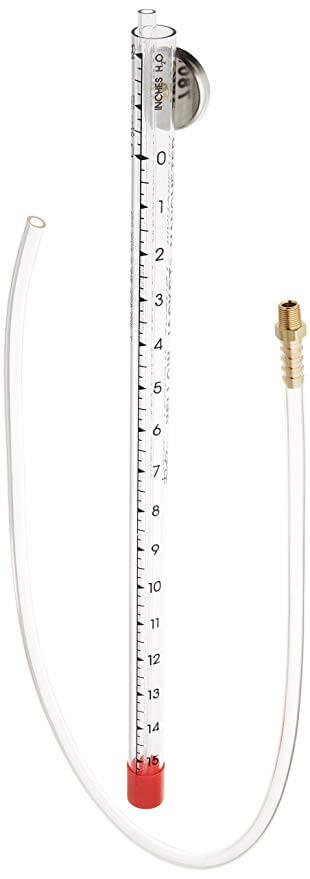
Strong magnet – Like any high-end manometer, the 78075 has a magnet on the tube that will keep it upright. It allows you to attach it to any ferrous metal and thus you can take readings with relative ease without having to fumble it in your hands.
Scale – On newer gadgets, the yellow jacket can measure pressure up to -2 inches per water column. However, the maximum is 15inWC. Also, the economical manometer allows you to set pressure for natural or L.P gas.
Weight: 4.8 ounces
Range: -2inWC to 15inWC
Who is it for?
The Yellow Jacket 78075 is a simple device and is designed for the DIY enthusiast, given that it is not for use in heating or cooling applications.
It is simple to use as all that is needed is to fit it with water
It is cost effective compared to hiring a professional and waiting for weeks before you get an appointment
Doesn’t include a storage case and thus you can lose some of the components
6. Hti-Xintai
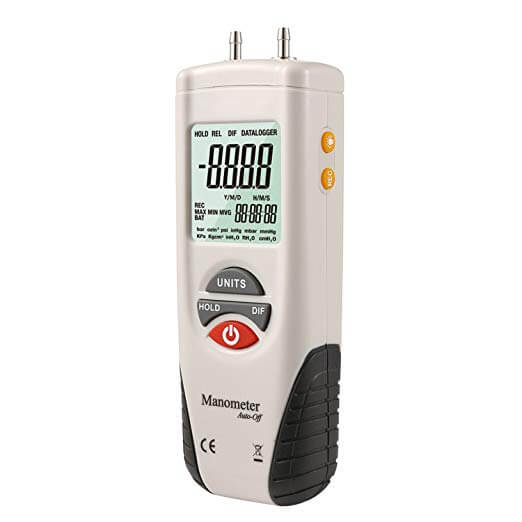
One fascinating feature of the gadget is its portability. It is lightweight, and you can carry it and use it in any environment. It can also be used as a differential unit to measure the pressure between two points.
However, our best features were the versatility and the high resolution.
Versatility – The Hti-Xintai has 11 selectable units of measure, and it is easy to toggle between the different gadgets with the unit button. Moreover, it is easy to use as there are buttons for various functions. You can turn the backlight on with the press of a button and is ideal for use primarily in low lit conditions. Measuring the difference will also be a walk in the park with the dif button, and you can capture the min, max, and average as well as record a reading.
High resolution – The Hti-Xintai resolution is unrivaled at 0.001psi. Thus the readings are more accurate.
11 units of measure
Range: +/-2 psi
Resolution: 0.001 psi
Who is it for?
The Hti-Xintai can be used by HVAC experts as well as for medical instruments. However, we recommend it for people looking for an affordable option.
It is dead accurate and has a high resolution
The unit is built to allow one-handed operation
It is affordable but still a quality unit
Allows you to troubleshoot dozens of aspects
The gadget has one shortcoming in that it freezes up
7.

First, the Risepro has a +/-2 PSI, +/-13.79kPa range. It also happens to be quite resourceful with 11 units of measure including PSI, mBar, kPa, inH2O, etc. Other than the broad category of units of measure, it also happens to have a high accuracy of +/-0.3%. The Risepro has a zero function to adjust and offset functions, and also includes a data hold function as well as max, min, and average function.
However, our best features were the ease of use and the low battery indicator.
Ease of use – The Risepro is for one hand use, so you free your hand for other activities. It also has a button for every function. It includes a unit button to toggle between the various units of measure. It consists of a backlight so you can take readings in dark areas.
Low battery indicator – Though it has an auto power off feature that shuts down the unit after long periods without use, the Risepro also includes a low battery indicator so you can know when the battery is running low.
Range: +/-2psi
Eleven selectable units of measure
Who is it for?
The Risepro can be used for gas appliance repair, and laboratory testing as well as computer peripherals. It is also ideal for people on a tight budget.
It is affordable and great for people on a tight budget or looking to make quick calculations
It is easy to take readings thanks to the huge LCD
There are concerns with the quality, and it will not last as long as our top picks
8. Dwyer Slack Tube Series 1211

First, the gadget includes magnetic clips that allow you to mount on any ferrous surface for hands-free operation. Moreover, the Dwyer has two tubing, and the fluid in one pipe will rise in direct proportion to the pressure applied to the next pipe. It can measure intermittent pressure up to 50psi and 20-inches of mercury. However, it features safety traps on the top of both columns preventing loss of fluids owing to surges in pressure. However, our best features were the construction and the scale.
Scale – First, the Dwyer scale is flexible spring-steel, and it is center-mounted to avoid parallax when taking readings. Moreover, it includes a 2-inch sliding zero allowing you to zero the scale.
Construction – First, the Dwyer 1211 has no loose caps or connectors that you can lose. Thus it is safe to use in congested workplaces. Moreover, it is easy to store and transport thanks to the connectors. Turning the connectors one revolution allows you to use it and turning it back seals the columns ensuring there is no fluid loss. Moreover, you can roll it up into a more compact unit do it is easy to store and transport. Finally, the molded-nylon construction is corrosion-free, leak-proof, and unbreakable so you can expect it to last.
Temperature range: 130°F
Connection: 1/8-inches
Max pressure: 50psi
Max vacuum: 20inHg
Who is it for?
The Dwyer series 1211 is fantastic for fan and blower tests, checking gas pressure, and adjusting control devices. We also recommend it for people on a budget. Though it is not the most inexpensive manometer on this guide, it is still an affordable unit.
It is durable as there are no loose connectors that one can lose and it is virtually unbreakable
It is reasonably-priced
It can measure an extensive range of pressure up to 50psi
The main manual doesn’t explain everything and filling it will be a challenge
9. RUPSE Hand-held HT-1890 Digital
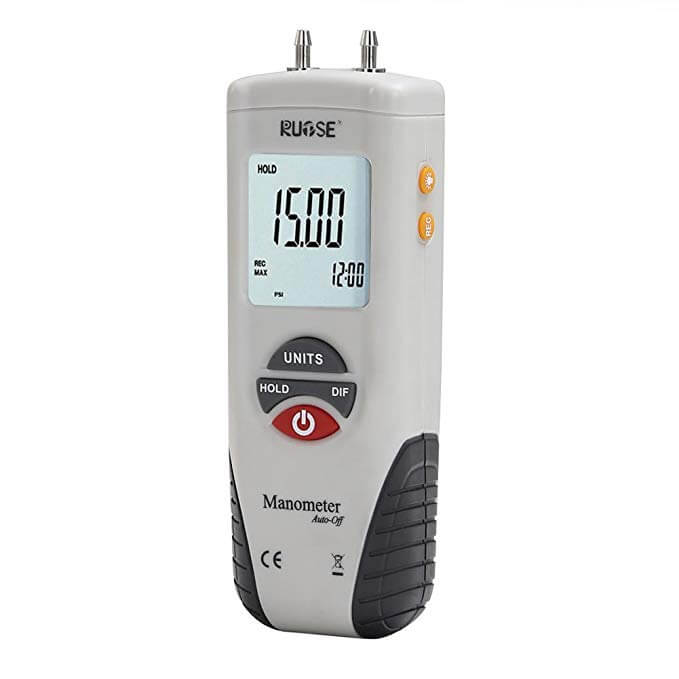
You can measure pressure in 11 different units, and the set includes a button that allows you to toggle between the various units of measure. And speaking of measuring pressure, you can measure a max of +/- 2psi with an accuracy of +/-0.3psi. However, our best features were the affordability and ease of use.
Affordability – The low price point of the Rupse is what has made it such a hit. It is a fraction of the cost of other manometers on this list and is great for people on a budget.
Ease of use – First, the HT 1890 has a button for nearly every feature. You measure differential pressure with relative ease as well as hold data and record max min and average. Moreover, it allows for one-hand use and finally has a backlit LCD allowing you to take readings in low lit areas.
Weight: 12.6 ounces
Pressure range +/-2psi
Working temp: 0-40°C
Storage temp: 0-60°C
Who is it for?
The Rupse HT 1890 is for HVAC professionals. With the backlit display, they can take pressure in ducts with relative ease. It is also great for pneumatic controls and medical equipment.
It is affordable
It is light, and you can use it with ease
It is not a high-quality device and cannot be recalibrated should calibration go off.
No magnet on the back
10. Testo 510
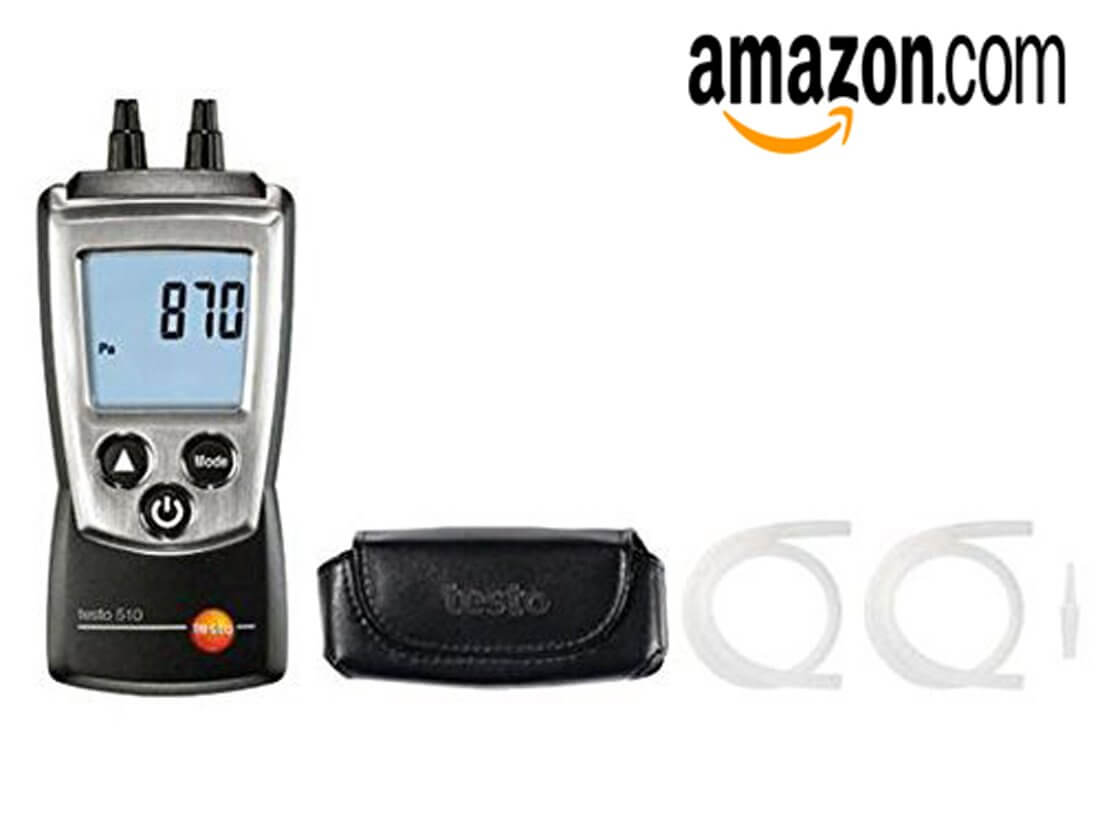
First, it is a digital option, and thus it will be pretty easy to use. Taking readings will be a breeze and especially in areas with low visibility thanks to the backlit display. Another fascinating feature of the Testo 510 is that you can test anything from 0 to 100mbar and that operating the gadget is a breeze. You can also measure psi, mmH2O, mmHg, ms, and fpm. You will also appreciate the pilot tube as it allows you to measure the ventilation duct up to 100m/s
Precise – The 510 accounts for air pressure and temperature ensuring that your readings are spot on and aren’t affected by the prevailing conditions. The accuracy will be in form of +/-0.03mbar (from 0 to 0.30mbar) and +/- 0.05mbar (0.31 to 1.00mbar).
Compact – One shortcoming with tech is that you cannot fit all features in a tiny device. Often you have to sacrifice functionality for size but not with the Testo 510. It is compact but still happens to be functional.
Weight: 2 pounds
Temperature compensation
Magnetic back
Who is it for?
We recommend the Testo for gas engineers and HVACR professionals. The 510 is affordable, lightweight, and one of the best units when it comes to gas testing equipment
The 510 has a protective cap, a belt pouch, and a wrist strap ensuring little to no damage comes to the tool
It is reasonably priced
Includes built-in magnets that allow for hands-free operation as you can clip it somewhere
It is compact, and thus it is easy to carry with you when on the go
Though it has protective features be careful not to drop it as it breaks easily
Best Manometers Selection Criteria
Manometers can either be simple, differential, or digital devices.
Simple – They measure the pressure of a liquid by comparing it with the atmospheric pressure. It is standard for measuring seepage control systems. It is also used in well-type manometers to measure low pressure. The inclined tube manometer also happens to be a simple type and measures smaller amounts of pressure. The inclined-tube option is renowned for being accurate.
Differential options on the other hand measure the difference of pressure between point 1 and 2. It can be within one pipe or two completely different places. They are great for diagnosing problems in HVAC systems.
Digital – These are the most common manometers and use a microprocessor and pressure inducer to measure pressure. The pressure transducer serves to sense changing pressure and that appears on the screen. First, their portability sets these devices apart from the rest as you can use without a level surface. Moreover, they are easy to read, they can record data and easily interfaces with computers.
What are you going to measure?
Pick your manometer having considered the gas or liquid whose pressure you are going to measure. First, mull over whether the liquid whose pressure you want to ascertain is miscible with the manometric fluid. Is it heavier too and what is the distance between the two points for which pressure is to be measured? The most common fluids are water and mercury, but we recommend the latter owing to its higher density.
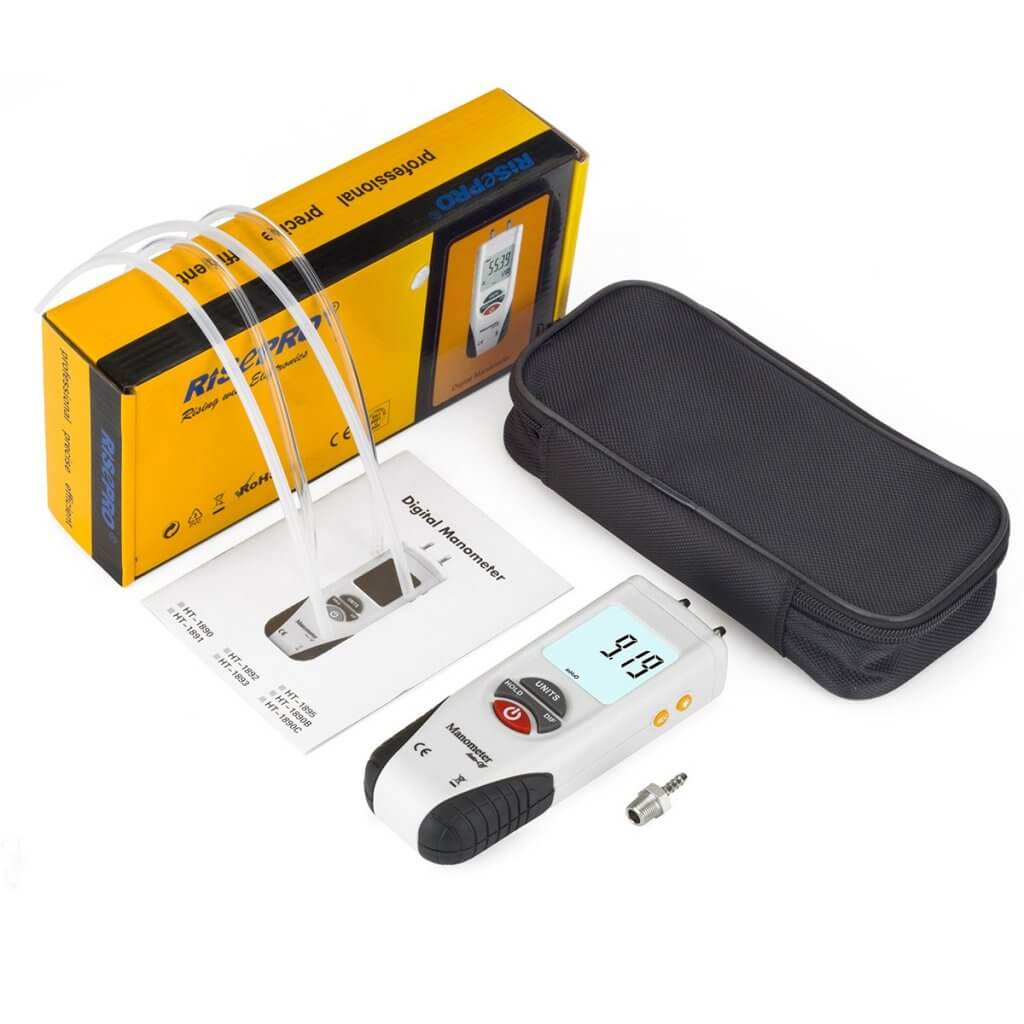
Intended Purpose
You can use a manometer for numerous applications. Manometers may be used in atmospheric surveys, gas analyses, and weather surveys. They can also be used for medical diagnosing in HVAC and gas grills.
Also, consider if you will be using the tool at home or a job site or you will be using it on the go. If it is the latter, we recommend you get a digital option thanks to it being portable and that it can record readings. A digital gadget is also great for HVAC experts thanks to the backlighting that allows you to record readings in dark places.
Performance and ease of use
First, always consider the liquid used in manometers. Often used are water and mercury, but benzene, colored water, and bromides work as well. However, consider the prevalent temp, the vapor and density before purchasing a manometer. Furthermore, you can get a digital or analog manometer. The latter are sturdy and well-built but some calculations are required, and the readings are not easy to take.
Therefore, we recommend you invest in a digital manometer as they are a breath of fresh air. They can hold data and are great for calculating differences. Moreover, some include batteries with and battery saving mechanism that turns off the device after some minutes without use. Digital manometers also have an LED display which is often backlit, so it is easier to take readings.
With the above information, you can make an informed purchase decision. However, we have done you one better and provided a list of the ten best manometers.
Frequently Asked Questions
How do a barometer and manometer differ?
Though both measure pressure, a manometer has one end closed, unlike a manometer which often has both arms open. A barometer is used to measure pressure relative to the vacuum, unlike a manometer which can measure pressure relative to the atmosphere or measure differential pressure.
Why is mercury still used in manometers despite its toxicity?
Mercury is toxic but still happens to be the preferred fluid in manometers owing to its density. It has a density higher than most fluids and thus is immiscible with most liquids. Moreover, the meniscus is visible and thus taking readings will be a breeze. Other fluids such as CC14 form an opaque layer on the columns which is not the case with mercury.
Moreover, it does not evaporate quickly thanks to the low vapor pressure, and the freezing point is much lower than water thus you can use it in cold climates.
Conclusion
Measuring pressure is as old as time, and the devices used have evolved to the digital manometers we have now. These are straightforward, and happen to be quite precise thus taking readings will be simple enough. Ensure you purchase a manometer that meets your demands and is within your budget. The list above should help you make an informed decision.
Also, if you feel there is something we missed, let us know in the comments below.




